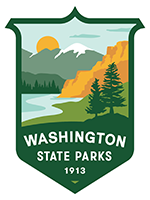Wildfire season is here and impacting several parks, so make sure you’re in the know before you go. Before you head to a park, please check its page or head to our alerts page for closures, alerts and other important information to make sure you have a fun, safe and informed trip.
Search results
975 results found
Two of Washington’s great rivers converge at Wenatchee Confluence State Park. This place connects different geologic terranes, Indigenous nations, fruit growers, packers and distributors, transportation networks, residents and visitors.
Pacific Pines State Park provides public access to the 27-mile-long beach fronting the Pacific Ocean on the Long Beach Peninsula, a stretch of sand and storm-driven waves dedicated to public recreation.
Griffiths-Priday Ocean State Park is set on a wide hard-sand beach where the Copalis River empties into the Pacific Ocean. The park’s waters and sands conceal evidence of a massive earthquake that transformed the surrounding landscape.
Rockport State Park is renowned for its forest of giant Douglas fir, western red cedar and western hemlock trees--some more than 600 years old. The classic old growth forest features large trees, standing snags, decaying logs and layered, multi-aged forest species. It has held great value for people through the ages, although it has been valued in different ways in different times.
Ike Kinswa State Park encompasses a rich history about the ways in which natural resources have been stewarded and exploited at the historic confluence of the Tilton and Cowlitz Rivers, now flooded by the reservoir behind Mayfield Dam.
Federation Forest State Park is an oasis of old growth forest preserved by women who banded together to effect social change and influence public policy despite barriers to their participation in political life.
In the park, Douglas fir trees soaring 200-300 feet high into the forest canopy have been growing for 300-400 years or more. Long after they die, their fallen trunks or standing snags continue to provide habitats for a diverse community of life.
Lincoln Rock State Park is a popular recreation area with access to Lake Entiat, the reservoir created by Rocky Reach Dam.
Indigenous Lands
The park lies within the traditional territories of Sahaptian and Interior Salish Indigenous people whose present-day descendants include members of the Confederated Tribes and Bands of the Yakama Nation and the Confederated Tribes of the Colville Reservation. For thousands of years this area has provided habitat for a diverse community of life that forms the basis of their cultures.
Ocean City State Park has been an oceanfront destination for generations. The park faces the Pacific Ocean at North America’s “active margin,” where the ocean-floor Juan de Fuca tectonic plate slowly sinks beneath the continent, sliding at a rate of about 13 feet per century in the plate’s subduction zone. Sudden movements of the Juan de Fuca Plate can cause earthquakes that may modify the land surface and generate tsunamis.
Lewis and Clark State Park preserves precious remnants of once-common southwest Washington landscapes along a historic Indigenous travel route.
Indigenous Lands
The park lies within the traditional territories of Coast Salish Indigenous people whose present-day descendants include members of the Cowlitz Indian Tribe and Confederated Tribes of the Chehalis Reservation. For thousands of years this area has provided habitat for a diverse community of life that forms the basis of their cultures.
Miller Peninsula State Park Property holds the potential to become one of Washington’s most beloved state parks. Perched on forested bluffs overlooking the marine passage into Washington’s inland waterways and sandwiched between the protected harbors of Discovery Bay and Sequim Bay, this quiet landscape has nonetheless been touched by many lives. For the S’Klallam people, this land is part of a homeland that spans the shores and uplands of the Strait of Juan de Fuca.
Lewis and Clark Trail State Park lies nestled in a grove of ponderosa pine trees in the valley of the Touchet River. The park is situated along a pathway used for thousands of years to connect the foothills of the Rocky Mountains with the salmon highway of the Columbia River.
Washington’s Sand Sea
Potholes State Park is set in a unique environment dominated by ancient sand dunes and a modern irrigation reservoir.
In the final stages of the most recent ice age, masses of glacial ice repeatedly blocked meltwater drainage, creating huge bodies of impounded water in northern Washington, Idaho and Montana. When the ice dams melted or were breached by the sheer weight of water behind them, gigantic Ice Age floods swept over the landscape.
Shoppers can conveniently explore merchandise on the new site
OLYMPIA – Nov. 29, 2021 – The Washington State Parks and Recreation Commission launched a new online store that provides customers with an improved experience when shopping for popular products.
The store features fan-favorite items including icon prints of each state park, Winter Recreation scarves, 2022 Parks calendars, guidebooks, Discover Passes and e-gift cards.
OLYMPIA – April 5, 2023 – The Washington State Parks and Recreation Commission will hold its regular hybrid commission meeting on Thurs., April 13, 2023, at The Historic Davenport Hotel in Spokane.
The public is welcome to attend in-person or online.
Agenda items include:
Steamboat Rock State Park preserves spectacular features of the Columbia Plateau Ice Age Floods. The 800-foot-tall butte of Steamboat Rock, sheer cliffs, and scoured coulees are remnants of a series of flood events that completely dwarf the imagination.
